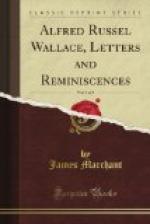[62] Angraecum sesquipedale, a Madagascar orchid, with a whip-like nectary, 11 to 12 in. in length, which, according to Darwin ("Fertilisation of Orchids,” 2nd Edit., p. 163), is adapted to the visits of a moth with a proboscis of corresponding length. He points out that there is no difficulty in believing in the existence of such a moth as F. Mueller had described (Nature, 1873, p. 223), a Brazilian sphinx-moth with a trunk 10 to 11 in. in length. Moreover, Forbes had given evidence to show that such an insect does exist in Madagascar (Nature, 1873, p. 121). The case of Angraecum was put forward by the Duke of Argyll as being necessarily due to the personal contrivance of the Deity. Mr. Wallace shows (p. 476, Quarterly Journal of Science, 1867) that both proboscis and nectary might be increased in length by means of Natural Selection. It may be added that Hermann Mueller has shown good grounds for believing that mutual specialisation of this kind is beneficial both to insect and to plant.
[63] “Variation of Animals and Plants,” 1st Edit., ii. 431. “Did He cause the frame and mental qualities of the dog to vary in order that a breed might be formed of indomitable ferocity, with jaws fitted to pin down the bull for man’s brutal sport?”
[64] See Wallace, Quarterly Journ. of Sci., 1867, pp. 477-8. He imagined an observer examining a great river system, and finding everywhere adaptations which reveal the design of the Creator. “He would see special adaptations to the wants of man in the broad, quiet, navigable rivers, through fertile alluvial plains, that would support a large population, while the rocky streams and mountain torrents were confined to those sterile regions suitable for a small population of shepherds and herdsmen.”
[65] At p. 485 Wallace deals with Fleeming Jenkin’s review in the North British Review, 1867. The review strives to show that there are strict limitations to variation, since the most rigorous and long-continued selection does not indefinitely increase such a quality as the fleetness of a racehorse. On this Wallace remarks that the argument “fails to meet the real question,” which is not whether indefinite change is possible, but “whether such differences as do occur in nature could have been produced by the accumulation of variations by selection.”
[66] Abstract of a paper on “Birds’ Nests and Plumage,” read before the British Association. See Gard. Chron., 1867, p. 1047.
[67] Sir Henry Holland, Bart., M.D., F.R.S., a writer on Mental Physiology and other scientific subjects (b. 1788, d. 1873).
[68] “This turns out to be inaccurate, or greatly exaggerated. There are no true alpines, and the European genera are comparatively few. See my ‘Island Life,’ p. 323.”—A.R.W.
[69] “In pigeons” and “lizards” inserted by A.R.W.
[70] See Westminster Review, July, 1867, p. 37.




